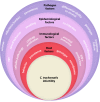Human and Pathogen Factors Associated with Chlamydia trachomatis-Related Infertility in Women
- PMID: 26310245
- PMCID: PMC4548260
- DOI: 10.1128/CMR.00035-15
Human and Pathogen Factors Associated with Chlamydia trachomatis-Related Infertility in Women
Abstract
Chlamydia trachomatis is the most common bacterial sexually transmitted pathogen worldwide. Infection can result in serious reproductive pathologies, including pelvic inflammatory disease, ectopic pregnancy, and infertility, in women. However, the processes that result in these reproductive pathologies have not been well defined. Here we review the evidence for the human disease burden of these chlamydial reproductive pathologies. We then review human-based evidence that links Chlamydia with reproductive pathologies in women. We present data supporting the idea that host, immunological, epidemiological, and pathogen factors may all contribute to the development of infertility. Specifically, we review the existing evidence that host and pathogen genotypes, host hormone status, age of sexual debut, sexual behavior, coinfections, and repeat infections are all likely to be contributory factors in development of infertility. Pathogen factors such as infectious burden, treatment failure, and tissue tropisms or ascension capacity are also potential contributory factors. We present four possible processes of pathology development and how these processes are supported by the published data. We highlight the limitations of the evidence and propose future studies that could improve our understanding of how chlamydial infertility in women occurs and possible future interventions to reduce this disease burden.
Copyright © 2015, American Society for Microbiology. All Rights Reserved.
Figures











References
-
- WHO. 2005. Prevalence and incidence of selected sexually transmitted infections. Chlamydia trachomatis, Neisseria gonorrhoeae, syphilis and Trichomonas vaginalis: methods and results used by WHO to generate 2005 estimates. WHO, Geneva, Switzerland: http://whqlibdoc.who.int/publications/2011/9789241502450_eng.pdf.
-
- CDC. 2013. Incidence, prevalence, and cost of sexually transmitted infections in the United States. http://www.cdc.gov/std/stats/sti-estimates-fact-sheet-feb-2013.pdf CDC, Atlanta, GA.
Publication types
MeSH terms
LinkOut - more resources
Full Text Sources
Medical

